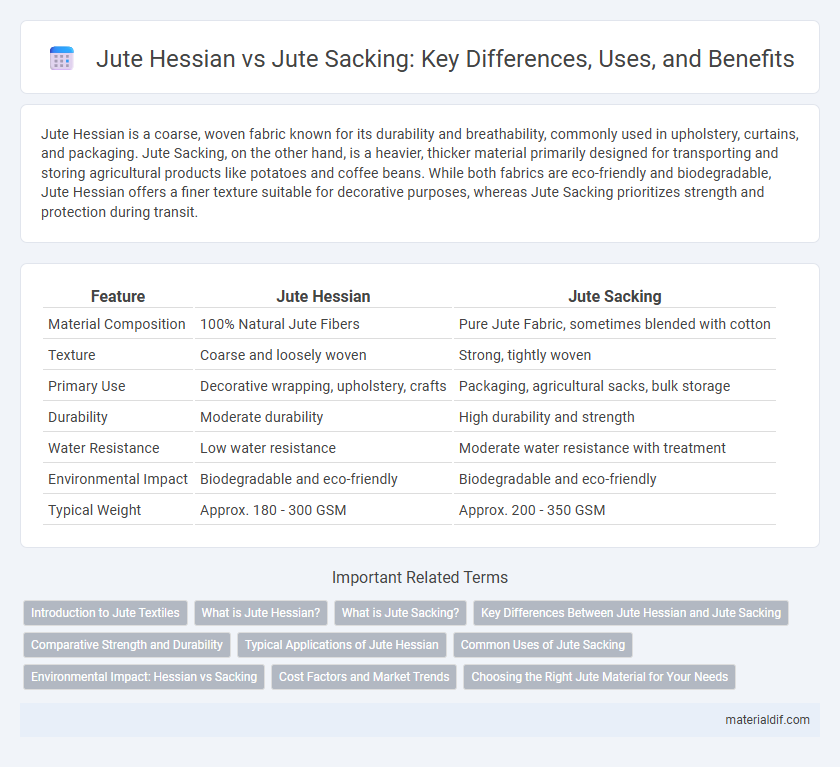Jute Hessian is a coarse, woven fabric known for its durability and breathability, commonly used in upholstery, curtains, and packaging. Jute Sacking, on the other hand, is a heavier, thicker material primarily designed for transporting and storing agricultural products like potatoes and coffee beans. While both fabrics are eco-friendly and biodegradable, Jute Hessian offers a finer texture suitable for decorative purposes, whereas Jute Sacking prioritizes strength and protection during transit.
Table of Comparison
| Feature | Jute Hessian | Jute Sacking |
|---|---|---|
| Material Composition | 100% Natural Jute Fibers | Pure Jute Fabric, sometimes blended with cotton |
| Texture | Coarse and loosely woven | Strong, tightly woven |
| Primary Use | Decorative wrapping, upholstery, crafts | Packaging, agricultural sacks, bulk storage |
| Durability | Moderate durability | High durability and strength |
| Water Resistance | Low water resistance | Moderate water resistance with treatment |
| Environmental Impact | Biodegradable and eco-friendly | Biodegradable and eco-friendly |
| Typical Weight | Approx. 180 - 300 GSM | Approx. 200 - 350 GSM |
Introduction to Jute Textiles
Jute Hessian and Jute Sacking are two primary forms of jute textiles, both derived from the natural fiber of the jute plant. Jute Hessian is a coarse, woven fabric commonly used for upholstery, curtains, and decorative purposes due to its durability and breathability. In contrast, Jute Sacking is specifically designed for heavy-duty packaging, including agrarian products like grains and potatoes, emphasizing strength and versatility in industrial applications.
What is Jute Hessian?
Jute Hessian is a coarse, woven fabric made from the fibers of the jute plant, predominantly used for its breathable and biodegradable properties. It is commonly utilized in upholstery, bags, and insulation due to its durability and eco-friendly nature. Unlike jute sacking, Hessian fabric has a finer weave and smoother texture, making it ideal for decorative and protective applications.
What is Jute Sacking?
Jute sacking refers to a coarse, woven fabric made from natural jute fibers, primarily used for packaging agricultural products like potatoes, coffee beans, and grains due to its durability and breathability. Unlike jute hessian, which is often finer and used in upholstery or decor, jute sacking is designed for heavy-duty applications, providing protection and ventilation during transport. Its biodegradable and eco-friendly properties make jute sacking a sustainable alternative to synthetic sacks in global trade and storage.
Key Differences Between Jute Hessian and Jute Sacking
Jute Hessian features a finer weave and smoother texture, making it ideal for upholstery and decorative purposes, while Jute Sacking is characterized by a coarser, thicker weave designed for heavy-duty packaging and transportation of goods. The strength of Jute Sacking allows it to withstand rough handling and heavy loads, whereas Jute Hessian prioritizes aesthetic appeal and breathability. Both materials are biodegradable and eco-friendly but serve distinctly different functional roles in industrial and domestic applications.
Comparative Strength and Durability
Jute Hessian and Jute Sacking are both made from natural jute fibers but differ in weave and application, affecting their comparative strength and durability. Jute Hessian, woven with a finer texture, provides moderate strength suitable for lightweight packaging and decorative uses, while Jute Sacking features a coarser, tighter weave that enhances tensile strength and resistance, making it ideal for heavy-duty industrial and agricultural applications. The durability of Jute Sacking generally surpasses Hessian due to its thicker fibers and robust construction, offering superior protection against wear and environmental factors.
Typical Applications of Jute Hessian
Jute Hessian is commonly used in upholstery, wall coverings, and as a backing material for carpets due to its breathable and lightweight properties. It also serves as a protective wrapping for plants and agricultural products, providing durability without restricting airflow. Unlike jute sacking, which is primarily designed for heavy-duty packaging and transportation, jute hessian supports decorative and functional applications in interior design and horticulture.
Common Uses of Jute Sacking
Jute sacking is primarily used for agricultural purposes such as packaging grains, potatoes, and coffee beans due to its breathable and durable properties. It also serves in landscaping for erosion control and as a protective covering for plants. Unlike jute hessian, which is often used in upholstery and crafts, jute sacking emphasizes functionality in heavy-duty storage and transport.
Environmental Impact: Hessian vs Sacking
Jute Hessian and jute sacking both offer eco-friendly alternatives to synthetic materials, but jute Hessian typically has a lower environmental impact due to its lighter weight and finer weave, which requires less raw material and energy to produce. Jute sacking, while biodegradable and compostable, is heavier and more robust, leading to higher water and pesticide usage during cultivation, slightly increasing its environmental footprint. Both materials contribute positively to soil health by being biodegradable and supporting sustainable agriculture, but Hessian is generally preferred for reducing resource consumption and environmental strain.
Cost Factors and Market Trends
Jute Hessian is generally more expensive than Jute Sacking due to its finer weave and higher quality finish, which demands more processing and labor costs. Market trends indicate growing demand for Jute Hessian in interior design and packaging industries, driven by sustainable and eco-friendly preferences, while Jute Sacking remains popular in agriculture and bulk commodity transport due to its durability and cost-effectiveness. Price fluctuations are influenced by raw jute availability, global trade policies, and increasing consumer preference for biodegradable materials.
Choosing the Right Jute Material for Your Needs
Jute Hessian offers a finer weave and softer texture, making it ideal for decorative purposes, upholstery, and lightweight packaging, while Jute Sacking features a coarser, heavier fabric suited for heavy-duty agricultural and industrial uses. Selecting the right jute material depends on durability requirements, breathability, and aesthetic preferences, with Hessian excelling in appearance and Sacking providing superior strength. Understanding the specific application ensures optimal performance, cost-effectiveness, and environmental benefits from these versatile natural fibers.
Jute Hessian vs Jute Sacking Infographic

 materialdif.com
materialdif.com